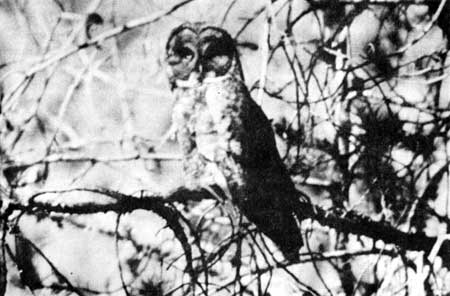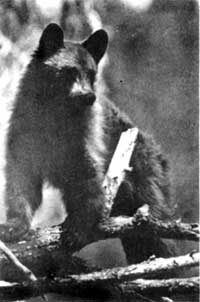
Great gray owl near Fort Klamath.
From Kodachrome by Welles & Welles
A Great Gray Owl Appears In The Park
By Harry C. Parker, Chief Park Naturalist, 1952-1955
An unidentified visitor was the source of evidence that the great gray owl, Scotiaptex n. nebulosa (Forster), ranges within this park. A dead specimen was picked up on the roadway one and one-half miles within the south boundary at about 7:10 a.m. on August 27, 1955. The bird appeared to have been killed by a car. It was prepared as a skeleton, and the specimen (CLNP 657) has been added to the park collection.
The bird was presented to the ranger on duty at the park’s South Entrance. He indicated that it should be taken to the Park Naturalist’s office at Park Headquarters. There the visitor turned the bird over to Ranger Naturalists Edward A. Burnham and John Mees. The donor was in such a hurry that he departed without having his name and address properly recorded. The ranger naturalists were able to recall that the gentleman was from Monterey, California, and that his name was something like “Gamelin,” “Gmelin,” “Gambling,” or “Gamble.” However, a later search of the Monterey telephone directory proved fruitless insofar as locating the man by this name is concerned.
There is little reason to question this record. The visitor appeared to be a reliable person who was well oriented in the park and who, therefore, should have believed correctly that he was inside the park when he found the bird.
The establishment of such a record is not unexpected. The experiences of Ranger Ralph Welles and his wife, Florence, with this bird in the Fort Klamath area have also been reported upon in this issue of Nature Notes from Crater Lake. I have, on numerous occasions during the autumn, heard great gray owls hooting at dawn in the forests near Wood River, south of Fort Klamath. I have seen them several times, although outside the Park, within a mile of the south boundary, along the road to Fort Klamath. However, to the best of my knowledge, this is the first time that the species has been recorded within the park.
It is to be hoped that great gray owls will be seen more often within the park, for they would make an interesting addition to our avifauna. In outward appearance, the great gray owl is the largest of the American owls. However, this is deceptive because, in actual body dimensions, it is exceeded by the great horned owl. The seemingly greater size of the great gray owl results from its much fuller feathering and the greater length of its tail. This bird inhabits primarily the northern forests and similar high-mountain forests, such as occur in the High Sierra of Yosemite National Park, where there are few people. In winter, the species may be found in more southerly areas, including Iowa and the Lake States. Individuals seen in such circumstances frequently appear to be quite unafraid in the presence of man.
References
American Ornithologists’ Union. 1931. Check-list of North American Birds (4th ed.). Lancaster, Pa., American Ornithologists’ Union. xix, 526 pp.
Bent, A. C. 1938. Life Histories of North American Birds of Prey (Part 2). Washington, D. C., Smithsonian Institution. viii, 482 pp.
Craighead, Frank, and John Craighead. (?)1956. Hawks, Owls and Wildlife. In press. Ca. 468 pp.
Farner, Donald S. 1952. The Birds of Crater Lake National Park.Lawrence, University of Kansas Press. xi, 187 pp.
(Mr. Parker has been Chief Park Naturalist at Grand Teton National Park, Wyoming, since December 11, 1955. – -Ed.)
Breakfast Interrupted
On the morning of July 31, 1954, I was making my way toward the rim of the lake. As I approached a meadow area, I chanced upon a Columbian blacktailed doe and her two fawns. The interesting part of the observation was that the two fawns were busily nursing the doe. As quietly as possible the camera was made ready, but the ever-alert mother sensed the presence of an intruder. Before a picture could be taken, mother and offspring were bounding gently and gracefully off through the meadow, leaving a disappointed photographer but a greatly enriched observer of nature.
Bear Statistics
By Richard M. Brown, Assistant Park Naturalist
 A young bear surveys his surroundings from a mountain hemlock lookout From Kodachrome by Welles and Welles |
William Rosenbalm — Bill to many of us — Truckdriver during the 1955 season, has served as a member of the maintenance staff in the park for several summers. He is therefore particularly well acquainted with the area, and he has come to know and recognize individually many of the bears that live here. On September 12, 1955, I finally found the long-awaited opportunity to chat with him for a while about “our” bears and to visit with him one of the places in the park bears frequently gather.
My patience was well rewarded by a most interesting conversation and a view of more bears at liberty that I had ever before seen all at one time. During this period, fourteen different bears, including eight adults and six cubs, were in evidence at one time or another. This occasion also gave me a chance to summarize Bill’s knowledge as of that date concerning the bear population in the park, with particular reference to the latest additions. The most recent previous study of the bears in this respect is that of Roland D. Walters (1953. Observations and census of the black bear in Crater Lake National Park. Nature Notes from Crater Lake 19:26-28), who reported a total of forty-one; this included twenty-two adults, six second-year cubs, and thirteen first-year cubs.
As a result of my discussion with Bill, thirty-two bears of the park’s total were accounted for as of that time. Of these, thirteen are adults and nineteen are cubs: the latter are all assumed to be first-year cubs. In spite of some possible error in this assumption, this indicates that the number of first-year cubs may be on the increase; in any event, according to the available data, it is not decreasing. Of course, a certain number of bears is overlooked in any estimate such as this.
The distribution of these bears by color phase is as follows: adults, ten black and three brown; cubs, thirteen black and six brown. Grouping them by families, and including odd individuals, gives this result: one black mother with three black cubs; two black mothers (one being Sally, each with three cubs, two black and one brown; one black mother with three cubs, two brown and one black; one black mother with two black cubs; one brown mother with two black cubs; one black mother with two cubs, one black and one brown; one black mother with one brown cub; Sandy, a brown male about five years old; Charlie, a black sister to Sandy; one black female, characterized by a light-colored “necklace” that continues down toward her belly as a stripe and by a flattened appearance when seen from the front, which has made herself quite a nuisance in the East Entrance area this summer; another black female; and one brown male. Perhaps the most unusual feature made evident by this compilation is the relatively high proportion of families, exactly one-half, having triplets.
Bill Rosenbalm certainly provides an outstanding example of the values that may be gained by patient and persistent observation of our wildlife. I know that he has found it a fascinating experience; this can be seen simply by the way he behaves when he is near the bears and by the way he talks about them. I am most grateful to Bill for his having shared with me the interest, enthusiasm, and fund of knowledge which he has found through his association with these animals.
(A later report by Bill Rosenbalm, recorded in the observation file and dated October 21, 1955, indicates an additional family consisting of a black mother with two black cubs; in the family consisting of a black mother with a single cub, the cub apparently should be classed as black rather than brown. This gives a total of thirty-five bears including, fourteen adults and twenty-one cubs. —R.M.B.)

